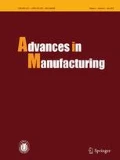Abstract
Three friction welding processes are compared for temperature, stresses and strains, as well as strain rates developed in the early phases of the processes, which are essential in their successful development. These are friction stir welding (FSW), linear friction welding (LFW) and rotary friction welding (RFW). Their common characteristic is the use of friction to generate adequate energy and raise temperature locally in order to create favorable conditions for welding at the interface between two parts. Although the mode of movement is different for each one of them, welds are produced through plastic deformation. The Lagrangian and coupled Eulerian-Lagrangian numerical models developed have produced results which are in qualitative agreement with experiments and have shed a light on the commonalities of these friction welding processes.







Similar content being viewed by others
References
Vairis A, Christakis N (2007) The development of a continuum framework for friction welding processes with the aid of micro-mechanical parameterisations. Int J of Modelling Identification and Control 2(4):347–356
Rosenthal D, Schrmerber R (1938) Thermal study of arc welding – experimental verification of theoretical formulas. Welding Research Supplement 17: 2–8
Schmidt H, Hattel J, Wert J (2004) An analytical model for the heat generation in friction stir welding. Modelling Simul Mater Sci Eng 12:143–157
Shi Q, Dickerson T, Shercliff HR (2003) Thermo-mechanical FE modelling of friction stir welding of Al-2024 including tool loads. The 4th International Symposium on Friction Stir Welding, Park City, Utah, USA, 14–16 May 2003
Schmidt H, Hattel J (2005) A local model for the thermo-mechanical conditions in friction stir welding. Modelling and Simulation in Mat Science and Eng 13:77–93
Vairis A, Frost M (2000) Modelling the linear friction welding of titanium blocks. Mater Sci Eng A 292:8
Turner RP, Gebelin JC, Ward RM et al (2011) Linear friction welding of Ti-6Al-4V: modelling and validation. Acta Materialia 59(10):3792–3803
Kavallaris NI, Lacey AA, Nikolopoulos CV et al (2007) Behaviour of a non-local equation modelling linear friction welding. IMA Journal of Applied Mathematics 72:597–616
Medvedev A, Vairis A, Nikiforov R et al (2012) Energy balance of the linear friction welding process. Journal of Engineering Science and Technology Review 5(3):20–24
Lacey AA, Voong C (2012) Steady-state mathematical models of linear friction welding. Quarterly Journal of Mechanics & Applied Mathematics 65(2):211–237
Li W, Vairis A, Preuss M et al (2016) Linear and rotary friction welding review. International Materials Reviews 61(2):71–100
Healy JJ, Mcmullan DJ, Bahrani AS (1976) Analysis of frictional phenomena in friction welding of mild steel. Wear 37:265–278
Bendzsak GJ, North TH, Li Z (1997) Numerical model for steady-state flow in friction welding. Acta Materialia 45(4):1735–1745
Midling OT, Grong O (1994) A process model for friction welding of Al-Mg-Si alloys and Al-SiC metal matrix composites-I: HAZ temperature and strain rate distribution. Acta Metall Mater 42(5):1595–1609
Sluzalec A (1990) Thermal effects in friction welding. International Journal of Mechanical Sciences 32(6):467–478
Alvise LD, Massoni E, Walløe SJ (2002) Finite element modelling of the inertia friction welding process between dissimilar materials. Journal of Materials Processing Technology 125:387–391
Papazafeiropoulos G, Tsainis AM (2015) Numerical modeling of the friction stir welding process. The 8th GRACM International Congress on Computational Mechanics, Volos, Greece, 12–15 July
Wang FF, Li WY, Li JL et al (2014) Process parameter analysis of inertia friction welding nickel-based superalloy. Int J Adv Manuf Technol 71:1909–1918
Johnson GR, Cook WH (1983) A constitutive model and data for metals subjected to large strains, high strain rates and high temperatures. Proceedings of the 7th International Symposium on Ballistics, Hague, Netherlands, pp. 541–547
Author information
Authors and Affiliations
Corresponding author
Rights and permissions
About this article
Cite this article
Vairis, A., Papazafeiropoulos, G. & Tsainis, AM. A comparison between friction stir welding, linear friction welding and rotary friction welding. Adv. Manuf. 4, 296–304 (2016). https://doi.org/10.1007/s40436-016-0163-4
Received:
Accepted:
Published:
Issue Date:
DOI: https://doi.org/10.1007/s40436-016-0163-4




